
SAN DIEGO — Artistic director, actor, and author, Sheldon Epps, has become a leader in the theater world, renowned for his work on both coasts of America and across the pond in London. Most recently, he directed “Blues in the Night” at our very own North Coast Repertory Theatre in Solana Beach. As a Black man, Epps often was forced to deal with the issue of race, yet, his articulate and insightful book, “My Own Directions” reveals that Epps views himself as a “director who has the good fortune to be Black with all of the skills, the wide-ranging knowledge, the soul and the proven ability that went along with that appellation.” Not only is his story impressive and supremely readable; it is also a great history lesson of historic and present-day race relations and the attendant hurdles.
Though born in Compton, California, Epps relocated to Teaneck, New Jersey, in his junior year of high school. His father’s career move brought the family to their new home, and leaving behind a nearly all-Black community, Sheldon suddenly found himself swimming in an unfamiliar pool with Jewish students who attended many of the same accelerated classes. Ever a driven, high achiever, Sheldon excelled in high school and was accepted into the highly competitive Carnegie Mellon University in Pittsburgh.
Over the next four years, Epps honed his craft and made many important connections with teachers, mentors, and classmates. At times, the book feels a bit like name-dropping, but why shouldn’t it? Epps really was rubbing elbows with many of the greats! To name but a few, Nina Vance, Mickey Rooney, and Richard Dreyfuss. In addition to sharing space with successful actors, Epps auditioned for and landed roles unheard of for a relative newbie. He acted in Pittsburgh Civic Light Opera’s summer stock, Papermill Playhouse, and BAM Theatre Company in NYC. Yet, Epps, a man driven by a vision, wrote that despite all of his great fortune, he “had the audacity to want more.”

In the chapters about Broadway and Off-Broadway, Epps shared some of the humiliating and infuriating encounters with directors who were unsure of how to treat actors of color; somehow they weren’t “right” for the role. In one particularly off-putting example, a famous director asked Epps to make his Romeo and Juliet audition a little more “streetsy.” Oy!
Directing was calling to Epps, and so, rounding up some of his Carnegie Mellon cohorts, The Production Company was formed. With a shoestring budget, the troupe used their limited resources, space, and sets to make the most out of their company by holding late-night cabarets and coffee houses to supplement ticket sales for the main stage productions! Clever. Not only was this frugal and creative, but it gave rise to one of Epps’ most produced shows, “Blues in the Night,” a cannon for the steamy songs of Bessie Smith, Alberta Hunter, and Ida Harold Arlen. This show has been performed for decades for audiences in New York, London’s West End, and Donmar Warehouse before being shopped to theatres all over the United Kingdom. It has most certainly reached every major city in the United States, and continues to win awards, including the Laurence Olivier Award twice!
Epps’ book is a lovely, very readable timeline of his significant achievements as a director who happens to have the good fortune to be a Black man. However, what leaps out for this reviewer is the persistent hurdles that people of color face in every career, and in every encounter. Regardless of the level of expertise born out through performance and productions, when Epps stepped in to revive the Pasadena Playhouse he had to constantly prove himself to patrons. They fretted that he was going to do too many “Black” shows. Thanks to the massive success of “Blues in the Night,” Epps feared becoming known as the director who “just does those Black musicals.” One artistic director hesitated when Epps said he’d like to direct “Twelfth Night” because she was concerned about “having two bBack directors in one season.” She was caught off guard when Epps queried, “In all the years that you’ve been an artistic director, has it ever occurred to you…having two White directors in one season as a problem?”
Eva Trieger is a freelance writer specializing in the arts. She may be contacted via eva.trieger@sdjewishworld.com